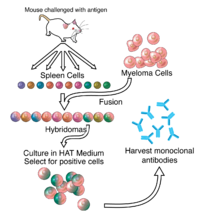
Multi-residue methodology for the determination of 16 coccidiostats in animal tissues and eggs by hydrophilic interaction liquid chromatography - Tandem mass spectrometry.
Sign Up to like & getrecommendations! Published in 2019 at "Food chemistry"
DOI: 10.1016/j.foodchem.2018.09.138
Abstract: A simple, sensitive and efficient confirmatory method was developed and validated for the determination of 16 coccidiostats in animal tissues and eggs using hydrophilic interaction liquid chromatography-tandem mass spectrometry (HILIC-MS/MS). The sample preparation consisted of… read more here.
Keywords: determination coccidiostats; methodology; liquid; coccidiostats animal ... See more keywords

Development of a monoclonal-based ic-ELISA for the determination of kitasamycin in animal tissues and simulation studying its molecular recognition mechanism.
Sign Up to like & getrecommendations! Published in 2021 at "Food chemistry"
DOI: 10.1016/j.foodchem.2021.129465
Abstract: To monitor the residue of kitasamycin (KIT), a monoclonal antibody against KIT was prepared, and a 50% inhibition concentration (IC50) of 5.7 ± 1.4 μg/L was achieved with the most sensitive antibody, KA/2A9, by optimizing ELISA conditions. The… read more here.
Keywords: based elisa; animal tissues; development monoclonal; kitasamycin ... See more keywords

Can plants indicate where a corpse is buried? Effects of buried animal tissues on plant chemistry: Preliminary study.
Sign Up to like & getrecommendations! Published in 2022 at "Forensic science international"
DOI: 10.1016/j.forsciint.2022.111208
Abstract: The bodies of murder or accident victims may be concealed below ground to cover up the crime by the perpetrator. During decomposition, nutrient-rich substances that may affect the surrounding environment enter the soil. The logical… read more here.
Keywords: chemistry; decomposition; vegetation; animal tissues ... See more keywords

Development of a heterologous enzyme-linked immunosorbent assay for the detection of clindamycin and lincomycin residues in edible animal tissues.
Sign Up to like & getrecommendations! Published in 2017 at "Meat science"
DOI: 10.1016/j.meatsci.2016.11.024
Abstract: In this study, new clindamycin (CLIN) artificial antigens were prepared and used to produce broad-specificity monoclonal antibodies. Based on the as-produced mAbs, a heterologous ELISA was developed to detect CLIN and lincomycin (LIN) residues in… read more here.
Keywords: lincomycin; lin; development heterologous; edible animal ... See more keywords

Development of a Multimatrix UHPLC-MS/MS Method for the Determination of Paracetamol and Its Metabolites in Animal Tissues
Sign Up to like & getrecommendations! Published in 2021 at "Molecules"
DOI: 10.3390/molecules26072046
Abstract: Paracetamol/acetaminophen (APAP) is one of the most popular pharmacologically active substances used as an analgesic and antipyretic agent. The metabolism of this drug occurs in the liver and leads to the formation of two main… read more here.
Keywords: method; paracetamol; multimatrix; determination paracetamol ... See more keywords